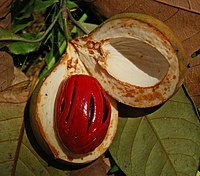
Photo from wikipedia
Arnica montana L. is a very important medicinal plant and simultaneously a European endemic endangered plant species. The morphological features and details of seed development and achene variability are poorly… Click to show full abstract
Arnica montana L. is a very important medicinal plant and simultaneously a European endemic endangered plant species. The morphological features and details of seed development and achene variability are poorly recognized. The aim of this study was to determine the impact of the achene position in the infructescence and the location of the inflorescence on the plant on the (i) morphological characteristics and germination ability of achenes, and (ii) recruitment of seedlings and their biometric features. Infructescences containing fully ripe achenes were randomly collected from A. montana individuals for the measurements and the germination experiment. Scanning electron microscopy, fluorescence microscopy, and light microscopy were used for characterization of flowers and achenes. The morphological traits of achenes and reproductive characteristics of A. montana were determined by the position of the achenes in the infructescence and the location of the inflorescence on the plant. The surface of arnica achenes is equipped with non-glandular and glandular trichomes, which is very rarely presented in species of the family Asteraceae. It is possible that the fluid-containing glandular trichomes are a source of essential oils. The peripherally located achenes were longer, thinner, and lighter. They were characterized by lower embryo weight, lower embryo/achene weight ratio, and lower germination capacity in comparison to the centrally located ones. The results presented in this article fill the gap in the knowledge of the morphology of achenes and the biology of the species, and provide information that can help in breeding programs, active protection, and field cultivation.
Journal Title: Plants
Year Published: 2022
Link to full text (if available)
Share on Social Media: Sign Up to like & get
recommendations!